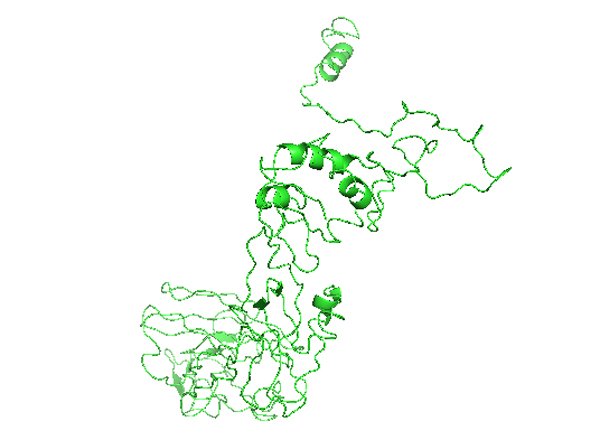Bioinformatics Database
SHH: Sonic hedgehog signaling molecule

Cellular Process
Bud stage of tooth development
Gene Name
SHH: Sonic hedgehog signaling molecule
Gene ID
6469
Gene Sequence
General Description
This gene encodes a protein that is instrumental in patterning the early embryo. It has been implicated as the key inductive signal in patterning of the ventral neural tube, the anterior-posterior limb axis, and the ventral somites. Of three human proteins showing sequence and functional similarity to the sonic hedgehog protein of Drosophila, this protein is the most similar. The protein is made as a precursor that is autocatalytically cleaved; the N-terminal portion is soluble and contains the signalling activity while the C-terminal portion is involved in precursor processing. More importantly, the C-terminal product covalently attaches a cholesterol moiety to the N-terminal product, restricting the N-terminal product to the cell surface and preventing it from freely diffusing throughout the developing embryo.
Alternative titles; symbols
SONIC HEDGEHOG
Chromosome
Chromosome 7
Cytogenetic location
7q36.3
Encoded Protein
Sonic Hedgehog Protein isoform 1 Preproprotein https://www.ncbi.nlm.nih.gov/protein/NP_000184.1/
Function of the protein in oral and tooth development
Studies by Cobourne et al, (2009) reports that Shh activity prevents apoptosis and subsequent palatal shelf fusion. In contrast, high levels of Shh in odontogenic epithelium arrests tooth development at the bud stage, secondary to a lack of cell proliferation in this region. The findings fo Cobourne et al, (2009) also illustrate the importance of appropriately regulated Hedgehog signalling during early craniofacial development and demonstrate that oro-facial clefting and hypodontia seen in NBCCS can occur as a direct consequence of increased Shh signal activity within embryonic epithelial tissues (Cobourne et al., 2009).
Dental and Oral Diseases
Nevoid basal cell carcinoma syndrome (NBCCS): NBCCS is an autosomal dominant or spontaneous disorder characterized by multiple cutaneous basal cell carcinomas, odontogenic keratocysts, skeletal anomalies and facial dysmorphology, including cleft lip and palate. Causative mutations for NBCCS occur in the PTCH1 gene on chromosome 9q22.3–q31, which encodes the principle receptor for the Hedgehog signalling pathway (Cobourne et al., 2009).
Solitary median maxillary central incisor syndrome (SMMCI): SMMCI is a complex disorder consisting of multiple, mainly midline defects of development resulting from unknown factor(s) operating in utero about the 35th–38th day(s) from conception. It is estimated to occur in 1:50,000 live births. Aetiology is uncertain. Missense mutation in the SHH gene (I111F) at 7q36 may be associated with SMMCI. The SMMCI tooth differs from the normal central incisor, in that the crown form is symmetric; it develops and erupts precisely in the midline of the maxillary dental arch in both primary and permanent dentitions. Congenital nasal malformation (choanal atresia, midnasal stenosis or congenital pyriform aperture stenosis) is positively associated with SMMCI. The presence of an SMMCI tooth can predict associated anomalies and in particular the serious anomaly holoprosencephaly. Common congenital anomalies associated with SMMCI are: severe to mild intellectual disability, congenital heart disease, cleft lip and/or palate and less frequently, microcephaly, hypopituitarism, hypotelorism, convergent strabismus, oesophageal and duodenal atresia, cervical hemivertebrae, cervical dermoid, hypothyroidism, scoliosis, absent kidney, micropenis and ambiguous genitalia. Short stature is present in half the children (Hall, 2006).
Protein Sequence
>NP_000184.1 sonic hedgehog protein isoform 1 preproprotein [Homo sapiens]
MLLLARCLLLVLVSSLLVCSGLACGPGRGFGKRRHPKKLTPLAYKQFIPNVAEKTLGASGRYEGKISRNS
ERFKELTPNYNPDIIFKDEENTGADRLMTQRCKDKLNALAISVMNQWPGVKLRVTEGWDEDGHHSEESLH
YEGRAVDITTSDRDRSKYGMLARLAVEAGFDWVYYESKAHIHCSVKAENSVAAKSGGCFPGSATVHLEQG
GTKLVKDLSPGDRVLAADDQGRLLYSDFLTFLDRDDGAKKVFYVIETREPRERLLLTAAHLLFVAPHNDS
ATGEPEASSGSGPPSGGALGPRALFASRVRPGQRVYVVAERDGDRRLLPAAVHSVTLSEEAAGAYAPLTA
QGTILINRVLASCYAVIEEHSWAHRAFAPFRLAHALLAALAPARTDRGGDSGGGDRGGGGGRVALTAPGA
ADAPGAGATAGIHWYSQLLYQIGTWLLDSEALHPLGMAVKSS
Mutations
Solitary median maxillary central incisor syndrome (SMMCI):
ILE111PHE : Nanni et al. (2001) identified an ile111-to-phe (I111F) mutation in the SHH gene. The dental anomaly was present in a girl, her mother, and her mother's sister. The affected daughter also had choanal stenosis.
Related Literature
Cobourne et al, (2009). https://doi.org/10.1016/j.ydbio.2009.04.021
Nanni et al., (2001). https://doi.org/10.1002/1096-8628(20010722)102:1<1::aid-ajmg1336>3.0.co;2-u
Hall R. K. (2006). https://doi.org/10.1186/1750-1172-1-12
